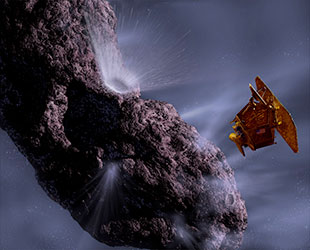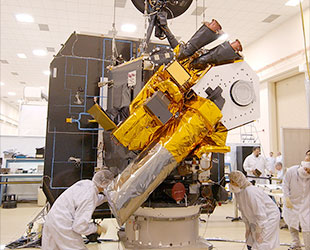September 20, 2013 — NASA's Deep Impact spacecraft has chased its last comet.
The agency declared
Deep Impact dead Friday (Sept. 20), six weeks after receiving its last communication from the veteran probe, which slammed an impactor into one comet and flew by another during its productive mission.
"Deep Impact has been a fantastic long-lasting spacecraft that has produced far more data than we had planned," principal investigator Mike A'Hearn, with the University of Maryland, said. "It has revolutionized our
understanding of comets and their activity."
Deep Impact launched in January 2005 on a mission to rendezvous with Comet Tempel 1. In July of that year, the spacecraft deployed an impactor into the comet, allowing scientists to study the icy body's composition.
Deep Impact then flew by Comet Hartley 2 in November 2010, as part of a broad extended mission dubbed EPOXI ("Extrasolar Planet Observation and Characterization" and "Deep Impact Extended Investigation").

Artist's impression of the initial encounter between NASA's Deep Impact spacecraft and Comet Tempel 1. (NASA/Pat Rawlings) |
From February through April 2012, Deep Impact observed Comet Garradd from afar and then snapped its first photos of the potentially-dazzling
Comet ISON in January of this year. The spacecraft also captured imagery of Earth, Mars and the moon, and observed six separate stars to confirm the motions of their orbiting planets.
Over the course of its mission, Deep Impact beamed back about 500,000 images and traveled 4.7 billion miles (7.58 billion kilometers) through deep space.
"Six months after [its] launch, this spacecraft had already completed its planned mission to
study Comet Tempel 1," said Deep Impact project manager Tim Larson, of the Jet Propulsion Lab in Pasadena, Calif. "But the science team kept finding interesting things to do."
"Through the ingenuity of our mission team and navigators and support of NASA's Discovery Program, [Deep Impact] kept it up for more than eight years," he added, "producing amazing results all along the way."

NASA's Deep Impact spacecraft, as seen prior to launch. (NASA) |
Mission controllers last heard from Deep Impact on Aug. 8 and repeated attempts to reactivate its on board systems were without success. The exact cause of the problem is unknown but the probe's managers suspect that an issue with computer time-tagging caused the spacecraft to lose control of its orientation in space.
As a result, Deep Impact likely had trouble positioning its radio antennas and solar arrays, making communications and generating power difficult. Without sufficient power, its propulsion systems and battery may have frozen up in the frigid depths of space, NASA officials said.
"Despite this unexpected final curtain call, Deep Impact already achieved much more than ever was envisioned," Lindley Johnson, Discovery Program Executive at NASA Headquarters and program executive for the mission, said. "Deep Impact has completely overturned what we thought we knew about
comets and also provided a treasure trove of additional planetary science that will be the source data of research for years to come."
